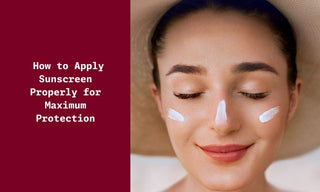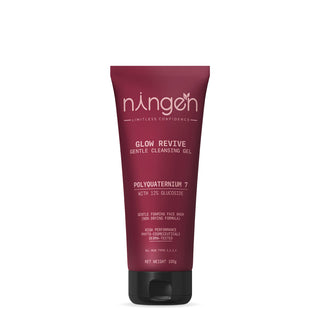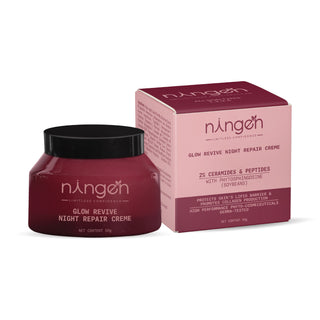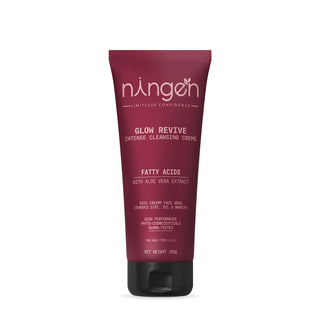SPF is your skin’s BFF. Sunscreen is essential to any skincare routine, yet many of us either skip it or don't apply it correctly. Whether you're spending a day at the beach, running errands, or just sitting by a window, your skin is exposed to harmful UV rays that can cause damage over time. Properly applying sunscreen ensures that your skin gets the protection required to prevent premature aging, sunburn, and even skin cancer. In this guide, we'll explain how to apply sunscreen cream properly for maximum protection so you can enjoy healthy, glowing skin all year round.
In This Article;
- Importance of Sunscreen for Skin Protection
- How to Apply Sunscreen Cream Properly For Maximum Protection?
- Wash Your Face Thoroughly
- Tone Your Skin
- Moisturize Before Applying Sunscreen
- The Right Amount of Sunscreen to Use
- What is the two-finger method?
- Types of Sunscreen Products
- Broad-Spectrum versus Non-Broad-Spectrum
- SPF Ratings and Their Importance
- How to Apply Sunscreen Cream on Different Areas of the Body?
- When and How Often to Reapply Sunscreen
- The Benefits of Consistent Sunscreen Use for Skin Health
- The Bottom Line
- Quick View
- Frequently Asked Questions
Importance of Sunscreen for Skin Protection
Sunscreen is vital for maintaining healthy skin & preventing damage from hazardous UV rays. It acts as a shield, protecting your skin from sunburn, premature aging, and even skin cancer. By forming a protective barrier, sunscreen helps prevent dark spots, wrinkles, and other signs of sun-induced damage. Whether it’s a cloudy day or bright sunshine, daily sunscreen application is a must for long-term skin protection and health. Prioritizing sunscreen not only keeps your skin radiant but also ensures lasting protection against environmental stressors.
How to Apply Sunscreen Cream Properly For Maximum Protection?
Proper preparation is key for maximizing the efficiency of your sunscreen. Following a simple skincare routine before applying sunscreen can enhance its protective benefits. This guide provides a straightforward method to prepare your skin, ensuring your sunscreen works efficiently.
1. Wash Your Face Thoroughly
Start by washing your face using a gentle cleanser, that’s suitable for your skin type. This step rubs out dirt, oil, and impurities hindering sunscreen absorption. Use lukewarm water for a soothing cleanse, avoiding harsh scrubbing that might irritate your skin.
2. Tone Your Skin
Apply a facial toner for balancing your skin's pH levels & removing any remaining impurities. Toning helps tighten your pores and prepares your skin for subsequent products. Choose an alcohol-free toner to avoid drying out your skin, especially if it's sensitive or dry.
3. Moisturize Before Applying Sunscreen Cream
After toning, apply a suitable moisturizer to ensure your skin stays hydrated throughout the day. This step is crucial as it creates a smooth base for the sunscreen, allowing it to spread evenly without leaving a white cast. For oily skin, a lightweight, oil-free moisturizer is best, whereas richer formulations may benefit dry skin types.
The Right Amount of Sunscreen to Use
Applying the correct amount of sunscreen is of utmost signifcance for effective sun protection. A common thumb rule is to use at least 1 ounce of sunscreen, which is roughly equal to the size of a shot glass, for covering the entire body. For a facial sunscreen, a nickel-sized amount is more than sufficient. This ensures adequate coverage and maximum protection against harmful UV rays.
What is the two-finger method?
The two-finger method is a simple way to ensure you're using enough sunscreen for proper protection. Here's how it works:
- Squeeze sunscreen along 2 fingers (your index & middle finger) from base to tip.
- This amount should be applied to your face and neck to provide sufficient coverage.
This method helps you apply the right quantity without needing to measure. It's a handy guide to make sure you're fully protecting your skin from harmful UV rays!
Also read: How to apply sunscreen on face?
Types of Sunscreen Products
There are two main types of sunscreen products based on their active ingredients and how they protect the skin:
- Physical (Mineral) Sunscreens:
- Key Ingredients: Zinc Oxide or Titanium Dioxide.
- How They Work: These create a physical barrier on top of the skin to deflect harmful UV rays.
- Pros: Ideal for sensitive skin, start protecting immediately after application, and less likely to clog pores.
- Cons: May end up leaving a white cast, especially on dark skin tones.
- Chemical Sunscreens:
- Key Ingredients: Avobenzone, Octinoxate, Oxybenzone, etc.
- How They Work: Absorbs UV rays & converts them into heat, which then gets released from the skin.
- Pros: Lightweight, blends easily without leaving a white cast, and is great for everyday use.
- Cons: Can irritate sensitive skin and requires a 20-30 minute wait before sun exposure.
Both types come in various forms, including lotions, creams, sprays, sticks, and gels, offering a variety of application methods to suit different skin needs.

Broad-Spectrum versus Non-Broad-Spectrum
Broad-spectrum sunscreens tend to offer protection against both UVA as well as UVB rays, which are responsible for premature aging and skin cancer. They guard against dark spots, wrinkles, and other signs of sun damage. Conversely, non-broad-spectrum sunscreens only protect against UVB rays, which cause sunburn but not necessarily the deeper skin damage caused by UVA. For maximum protection, always choose a broad-spectrum sunscreen to ensure a comprehensive shield against harmful rays during sun exposure.
SPF Ratings and Their Importance
SPF (aka Sun Protection Factor) indicates how well a sunscreen can shield your skin from UVB rays. Higher SPF ratings offer greater protection. For daily use, an SPF of at least 30 is recommended, providing about 97% protection against UVB rays. For extended outdoor activities, higher SPFs, like 50 or above, offer increased protection. However, no sunscreen is powerful enough to block 100% of UV rays. Remember, the effectiveness of any SPF depends on proper application and reapplication, especially after swimming or sweating.
How to Apply Sunscreen Cream on Different Areas of the Body?
Proper sunscreen application is key to protecting your skin from UV damage. Different areas of the body require specific techniques for optimal coverage.
Face & Neck: Use a nickel-sized amount of broad-spectrum sunscreen. Apply evenly over the face, covering the hairline, ears, and under the jawline. For the neck portion, apply generously & use upward strokes.
Body: Use around a shot glass-sized amount for your whole body. Focus on often-missed spots like the tops of the feet, back of the knees, and neck. Reapply every two hours or after swimming/sweating. Tailor your sunscreen choice to your skin type for best results. Always include sunscreen in your daily routine, rain or shine.
When and How Often to Reapply Sunscreen
Apply sunscreen in the morning as part of your routine, but remember its effectiveness decreases with time, moisture, and wind. Irrespective of the type of your skin, try to apply after every two hours. Choose broad-spectrum SPF and don’t forget SPF lip balm for full coverage. Pair sunscreen with protective clothing and limited sun exposure for maximum skin protection.
Reapplying sunscreen every two hours is essential for optimal protection against sun damage, especially when outdoors. If you are swimming or sweating, reapply it immediately after towel drying, even with water-resistant formulas.
The Benefits of Consistent Sunscreen Use for Skin Health
- Keeps your skin protected from harmful impacts of UVA & UVB rays
- Prevents premature aging, dark spots, and fine lines
- Reduces the risk of skin cancer
- Suits all types of skins (including oily as well as sensitive skin)
- Helps maintain an even skin tone
- Prevents sunburn and sun damage
- Supports long-term skin health and youthful appearance
Also read: Does sunscreen prevents tanning?
The Bottom Line
Incorporating sunscreen into your daily skincare routine is one of the most effective steps you can take to protect your skin. From preventing premature aging & sunburn to minimizing the risk of skin cancer, sunscreen provides essential protection against harmful UV rays. Whether you prefer a physical or chemical sunscreen, make sure to choose a broad-spectrum product with an appropriate SPF for your skin type. Apply the right amount, reapply throughout the day, and combine with other protective measures like clothing and shade to ensure your skin remains healthy and radiant.
Quick View:
Sunscreen is crucial for protecting your skin from UV rays, premature aging, and skin cancer. To ensure maximum protection, wash, tone, and moisturize your skin before applying a broad-spectrum sunscreen. Use the "two-finger method" to measure the right amount, and don't forget to reapply every two hours. Choose the right sunscreen for your skin type and complement it with protective clothing. Sunscreen should become a consistent part of your skincare routine, rain or shine.
Frequently Asked Questions
1. How much sunscreen should I apply on my facial skin?
Use about a nickel-sized amount to cover your face and neck properly.
2. What is the "two-finger method" for applying sunscreen?
It refers to squeezing sunscreen along two fingers (index and middle) to measure the right amount for your face and neck.
3. How often should I reapply sunscreen?
Every 2 hours or immediately right after sweating.
4. Can I use the same sunscreen over my face and body?
Yes, but facial sunscreens are often formulated for more sensitive skin and may be lighter in texture.
5. Is sunscreen necessary on cloudy days?
Yes, up to 80% of UV rays can penetrate clouds, so sunscreen is important year-round.
6. What’s the difference between physical and chemical sunscreens?
A Physical sunscreen can block & reflect UV rays, while chemical sunscreens tend to absorb and convert them into heat.
7. Do I really need sunscreen if I have dark complexion?
Yes, everyone, regardless of skin tone, needs protection from UV rays to prevent skin damage and cancer.
8. Does a higher SPF provide better protection?
Higher SPF offers your skin more protection, but no sunscreen is capable of blocking 100% of UV rays. Generally, SPF 30 is a good choice for daily usage.
9. Can sunscreen prevent wrinkles and fine lines?
Yes, sunscreen protects against UV damage, which is a major cause of premature aging and wrinkles.
10. What is the rule to apply sunscreen?
The general rules for applying sunscreen effectively are as follows:
- Use the Right Amount:
- For your face, apply about a nickel-sized amount (approximately 1.5 grams).
- For your body, use about an ounce (approximately the size of a shot glass) to cover all exposed areas.
- Apply Before Sun Exposure:
- Put sunscreen on 15-30 minutes before going outside. This allows it to absorb and provide maximum protection.
- Even Coverage:
- Apply sunscreen evenly across all exposed skin areas, including often-missed spots like the tops of your ears, the back of your neck, and your feet.
- Reapply Regularly:
- Reapply the sunscreen within every 2 hours, or more often if swimming or sweating, even if you’re using a water-resistant formula.
- Choose Broad-Spectrum:
- Opt for a broad-spectrum sunscreen, which protects against both UVA & UVB rays for a comprehensive protection.
- Check the SPF:
- Go for a sunscreen with at least SPF 30 for daily usage, which blocks about 97% of UVB rays.
- Don’t Forget Other Protections:
- Complement sunscreen use with protective clothing, hats, and sunglasses to enhance your skin protection.
11. What’s the best way of applying sunscreen over my makeup?
Go for a sunscreen spray or a powder sunscreen with SPF to reapply without disturbing your makeup.












